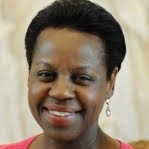
Each year AAM’s Education Committee (EdCom) Professional Network recognizes outstanding museum educators and supporters, programs and resources that exemplify excellence. The 2018 Award of Excellence in Practice was received by Maria Marable Bunch. Here, Ms. Bunch reflects on her distinguished career as a museum educator and provides some insight into remaining relevant in changing times. Nominations for awards are now open until January 31, 2019.
As I reflect on my career as a museum educator, I can’t say there was a specific jolting moment, experience, or place that suggested, “Follow that path, to museums, collections, and people.” It was a gradual progression of people and opportunities that steered me down my career path.
Where it all began:
I come from a family of “wonderers” and curious folks. With five children in tow, my parents were always exploring museums, national parks, historic sites, our neighborhood, and they even managed to turn our backyard into a place of adventure with gardens and to practice camping skills like pitching tents and cooking on a Coleman stove. My parents were also very observant of their children’s special talents. In me, they saw an interest and talent in the fine arts. By the time I reached seventh grade, I was enrolled in private art classes that I continued throughout high school. Needless to say, I had the opportunity to visit many art museums and galleries along the way. It was expected that I would continue my education in the arts beyond high school.
I was accepted to attend the Pennsylvania Academy of the Fine Arts in Philadelphia with joint studies at the University of the Arts where I majored in painting, printmaking, and art history. It is at the Academy that I got my first glimpse of a museum (of any kind) from the inside out. The Academy is part of a museum/school complex. The lower levels are the classrooms and studios, the upper levels are the museum galleries of the Pennsylvania Museum of American Art. The museum holds a remarkable collection of art by American artists, many who studied at the Academy. When inspiration for my own work began to escape me I would run up the grand staircase of this Frank Furness designed building to the galleries and linger over the works of Eakins, Pippins, Hendricks, Cassatt, and others. Without fully understanding it at the time, my being drawn to the galleries to study, to learn, to muse, were the powers of museums to captivate visitors I later grew to appreciate.
While studying at the Academy, I also learned the importance of people in these special places called museums. Down the Benjamin Franklin Parkway from the school is the Philadelphia Museum of Art that appeared to hover over the city. Like most college students, approaching the end of the spring semester, I was in pursuit of a summer job. I decided to wander down that Parkway to see what opportunities I could find there. They did not have any paid jobs to offer but were seeking interns for a range of projects. I managed to find a job that summer that allowed me the time to also accept the internship opportunity. It was this experience that introduced me to the power and impact that mentors could have on one’s career endeavors. I engaged in several internship opportunities at the museum throughout the remainder of my undergraduate studies. My assignments ranged from serving in the public affairs office to assisting the women’s committee to plan the first Philadelphia Craft Show to the education department. As I became more aware of the work of museums, I initially thought that I would like to pursue directorship or research. However, the people engaging side of museum work grabbed my attention more.
So, who were the individuals that inspired my interest in pursuing museum education? In the early stages of building their own careers, I had the remarkable opportunity to work with Patterson Williams who later became director of education at the Denver Art Museum, Tara Robinson who moved on to the Detroit Institute of Art as the director of exhibitions, Carol Stapp who is currently the director of the Museum Education Program at George Washington University in Washington, DC, Marla Shoemaker who became director of the education department at the museum and recently retired, and Clarence Wood, an artist educator, working through the museum’s Department of Urban Outreach programs showed me that pursuing ones work as an artist enhances your experiences as a museum educator. I often got to sit in on conversations between Anne d’Harnoncourt, the then young newest curator at the museum and eventually the director, with the education staff discussing the intersection of education and exhibitions. As a young, not so confident African American woman, who knew that I would end up in this place and time and be embraced by such remarkable individuals who could have otherwise dismissed my presence and desire to know more about the museum field? After the completion of my undergraduate studies, I received a phone call from Carol Stapp encouraging me to consider the George Washington University’s newly established Museum Education Program, while convincing me that I can and should seriously pursue a career in the museum profession.
Following my graduate studies, I embarked on a most unexpected journey. It was at this point in my life that I realized that like my parents, I was not shy about exploring the unexpected. I did not know at the time where my career and personal life path would take me but I was ready for the challenges. Or as ready as you can be about the unknowns coming your way.
My unconventional career path:
With my formal education behind me and my career on a roll, I traveled many paths that touched my professional growth. I worked in a variety of museums from children to art to history and even an historic site. That occurred because I was willing to consider following the job opportunities that led me to live on the West coast, the East coast, upper Northeast, and the Midwest, too. Some may consider it job hopping but the uniqueness of it all was I gained a broader understanding of the impact—culturally and socially—museums have across the country for a diverse population, in diverse environments. This had a profound effect on how I approached my work.
Along the way, I learned the importance of knowing your audience and how best to serve them. Studying demographic data becomes as important as knowing the museum’s collection. Practicing flexibility and embracing new ideas and approaches can lead you to unexpected opportunities for introducing new educational programming and resources. I always made sure to reach out to colleagues in neighboring museums. Networking with colleagues (local and national) can lead you to collaborative opportunities that could expand the reach of your program offerings to audiences that may not have visited your museum or theirs. My greatest challenge and success as a museum educator was the museum school partnership with the District of Columbia Public Schools and the Smithsonian Institution. This five year project allowed me to navigate the worlds of formal and informal education and discover how to merge them both to create impactful self-learning experiences for students, provide teachers with new tools for guiding student learning, increase parent participation in schools and other cultural institutions that benefits the family, and gaining the attention of public officials and policymakers to embrace museums as cultural institutions that can and do contribute to the vitality of a city, town, or rural community.
That experience propelled me into a deeper belief and understanding that museums can be active participants in society and safe places of mutual discourse on social issues. That led me to tackle challenging programs and projects like addressing a state mandate to support early childhood learning by introducing an early childhood program that welcomed for the first time, preschoolers into the galleries of a prominent art museum offering formal hands-on learning experiences about fine art. And my most recent endeavor to highlight our nation’s archival collection of federal documents like the Declaration of Independence, the Constitution, and the Bill of Rights, depicting our national governing history and practices through a series of national conversations on rights and justice. I recently joined the National Museum of the American Indian where one of my major responsibilities is to address the gaps in American education about Native American history and culture through its new national education initiative, Native Knowledge 360. This new program aims to promote a new and accurate perspective on Native American history, culture, and contemporary lives for teachers and students.
Living a life of purpose:
I was fortunate to have a very supportive spouse where together we carved a continuous changing course with our careers—both museum professionals—that offered us experiences that we would not have been able to plan or imagine. In addition, we managed to raise two daughters (one attended a museum-based preschool) and I continued to practice as an artist. I have been in the business of museum education for a long time. Through it all, I have lived a life fulfilled with purpose and commitment. I’ve gained so much along the way from family, friends, and colleagues and my way of giving back is to take advantage of every opportunity to mentor newcomers to the field. This is my way of acknowledging all who have touched me in my pursuit of excellence in practice, and there were many.









What a delightful accounting of a life in museums that continues to bring value and learning to others! I love that you started as an artist and continue to practice in that creative endeavor – no doubt it brought you energy and inspiration for your work over the years, most recently at NMAI. I enjoyed hearing about the special people who mentored you along the way and the desire you feel to continue that sharing with others coming up in the field. Thank you for your dedication and contribution to the evolution of museum education and lifelong learning. And congratulations on this very appropriate award for excellence in practice!
Your experiences are marvelous and it is good to also see that you and your husband have similar professional interests. When I read your account of your career, it reminded me of another Marable (William Manning Marable) who was also a history and political science follower and followed his dreams. Great minds, too. Congratulations